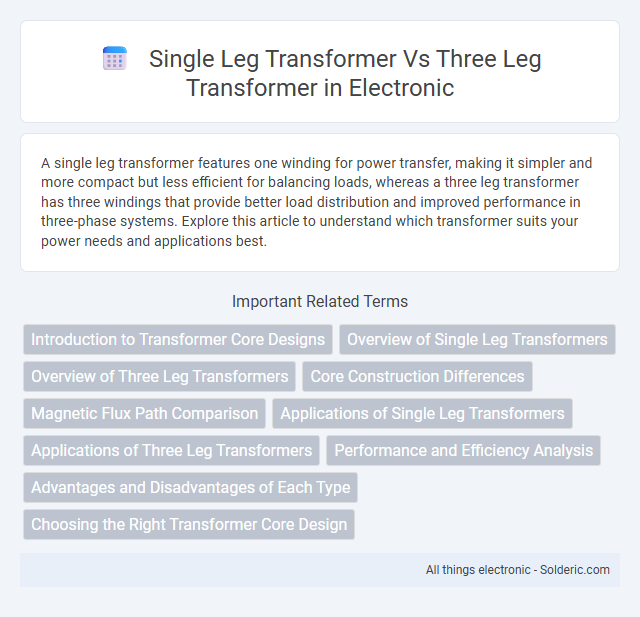A single leg transformer features one winding for power transfer, making it simpler and more compact but less efficient for balancing loads, whereas a three leg transformer has three windings that provide better load distribution and improved performance in three-phase systems. Explore this article to understand which transformer suits your power needs and applications best.
Comparison Table
| Feature | Single Leg Transformer | Three Leg Transformer |
|---|---|---|
| Core Structure | One magnetic leg/core | Three magnetic legs/cores |
| Phase Handling | Single-phase transformer | Three-phase transformer |
| Size and Weight | Smaller, lighter | Larger, heavier |
| Cost | Lower cost due to simpler design | Higher cost due to complexity and materials |
| Efficiency | High efficiency for single-phase applications | Efficient for balanced three-phase loads |
| Applications | Residential, single-phase power supply | Industrial, three-phase power distribution |
| Magnetic Flux | Single magnetic flux path | Three magnetic flux paths, can share flux |
| Maintenance | Simple maintenance | More complex maintenance due to design |
Introduction to Transformer Core Designs
Single leg transformers feature a core with one magnetic path, making them simpler and more compact, ideal for low-power or specialized applications. Three leg transformers utilize a core with three magnetic paths, enabling better magnetic flux distribution and improved efficiency for balanced three-phase power systems. Your choice between these designs impacts transformer size, performance, and suitability for specific electrical requirements.
Overview of Single Leg Transformers
Single leg transformers consist of a single magnetic core leg with one or more windings, primarily used for stepping voltage up or down in applications requiring compact and cost-effective solutions. These transformers exhibit simpler construction, lighter weight, and lower manufacturing costs compared to three leg transformers, making them suitable for low-power or specialized uses. The single core leg design limits their capability to handle unbalanced loads and reduces efficiency in applications requiring multiple phases or high power transfer.
Overview of Three Leg Transformers
Three leg transformers feature a magnetic core with three limbs, allowing efficient flux distribution and balanced phase loading in three-phase power systems. This design minimizes core material usage while maintaining high performance and reducing losses, making it ideal for industrial and utility applications. Compared to single leg transformers, three leg transformers offer enhanced stability and improved voltage regulation across all phases.
Core Construction Differences
Single leg transformers feature a core with one vertical limb surrounded by coils, resulting in a simpler magnetic path and reduced core material usage. Three leg transformers have a core with three vertical limbs interconnected by horizontal yokes, providing balanced flux distribution and improved mechanical stability. The distinct core geometries influence the magnetic flux paths and impact the overall efficiency and size of the transformers.
Magnetic Flux Path Comparison
Single leg transformers feature a simple magnetic flux path with one core leg concentrating the flux, which can lead to increased flux density and potential saturation under high load conditions. Three leg transformers distribute the magnetic flux through three separate core legs, minimizing flux density in each leg and reducing core losses while improving efficiency. Your choice between single leg and three leg transformers directly affects the magnetic flux distribution and overall transformer performance.
Applications of Single Leg Transformers
Single leg transformers are commonly used in applications requiring simple, low-cost power distribution where load balancing is not critical, such as small industrial equipment, residential power supply, and specific control circuits. Their design supports unbalanced loads and is ideal for localized voltage regulation or step-down voltage needs. Your choice of a single leg transformer suits scenarios demanding compact size and basic functionality without the complexity of three-phase systems.
Applications of Three Leg Transformers
Three leg transformers are widely used in three-phase power systems for industrial and commercial applications due to their ability to efficiently handle unbalanced loads and provide voltage regulation. Their design supports essential functions in power distribution networks, motor control centers, and renewable energy integration, making them ideal for maintaining stability and reliability in complex electrical grids. You can rely on three leg transformers for consistent performance in environments where three-phase power management is critical.
Performance and Efficiency Analysis
Single leg transformers typically exhibit lower efficiency due to unbalanced magnetic flux distribution, resulting in increased core losses compared to three leg transformers. Three leg transformers provide improved performance by effectively balancing the magnetic flux across all three limbs, reducing core saturation and enhancing voltage regulation. This balanced design leads to higher energy efficiency and more stable operation under varying load conditions.
Advantages and Disadvantages of Each Type
Single leg transformers offer a compact design and reduced material costs, making them ideal for limited space installations and lighter load requirements, but they typically provide less phase balance and lower overall efficiency compared to three leg transformers. Three leg transformers ensure better voltage regulation, improved phase balancing, and higher capacity for power distribution, which is essential for heavy-duty industrial applications, though they involve higher construction costs and larger physical footprints. Choosing between these types depends on operational demands, budget constraints, and space availability, with single leg transformers favoring simplicity and cost savings, while three leg transformers prioritize performance and reliability.
Choosing the Right Transformer Core Design
Selecting the right transformer core design involves understanding the operational requirements and efficiency needs of single leg versus three leg transformers. Single leg transformers feature a single magnetic path, making them simpler and cost-effective for low-power applications with less complex load balancing. Three leg transformers provide better magnetic flux distribution and higher efficiency in three-phase power systems, offering improved performance in industrial or large-scale electrical networks.
single leg transformer vs three leg transformer Infographic

 solderic.com
solderic.com